Mia Liu’s (劉文瑄) first performance art piece took place at New York’s Guggenheim Museum. Well, kind of. Liu, 31, had been working at the museum as a ticket taker while doing an MFA at Hunter College when she came up with the idea of printing the title of her own show on the museum’s tickets. Fearful of losing her job, however, she only handed out a few. She then came up with another plan — to display her work in the museum’s staff room.
“Then I could put on my resume that I’d had a solo show at the Guggenheim,” Liu said. She approached her boss with the idea, “and he looked at me like I was crazy,” she said.
It’s unfortunate Liu didn’t take either action to any kind of conclusion because it would have subverted the museum’s curatorial policies, raised interesting questions as to how artists exhibit at major art museums and offered a reconsideration of what constitutes museum space (should we consider a staff room part of Guggenheim’s exhibition area?).
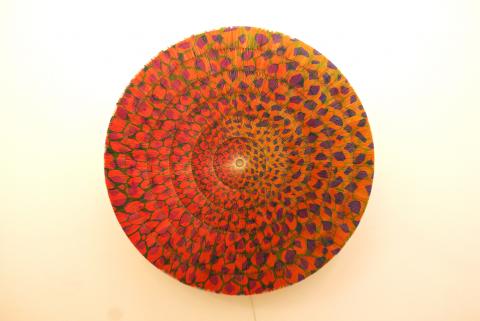
Photo: Noah Buchan, Taipei times, and courtesy of Mia Liu
Though an official Guggenheim show has yet to materialize for Liu, she did convince the museum to sell her 200,000 of its tickets, 60,000 of which she has used in Guggen’ Dizzy, a large-scale trompe l’oeil sculptural triptych currently on view at IT Park. The sculpture is part of I Can’t Tell You, but You Feel It (我無法告訴你), a solo show of her work that includes photography and installation. This review focuses on the sculpture.
Guggen’ Dizzy appeals because its simple elements combine in a way to create complex visual illusions reminiscent of optical art. Liu began the work with a series of doodles, sketches and drawings of basic geometric objects, scanned the bits into a computer and pieced them together to form a template of the sculpture’s overall design.
With the help of assistants, she attached, one by one, 20,000 tickets to one of three circular boards, each made up of six concentric circles. Colored masking tape was stuck to the edges of the tickets, that when combined form the original patterns. The boards were then mounted onto metal brackets and clamped onto a motor, which when switched on rotates slowly. The three-panel sculpture took three years to complete.
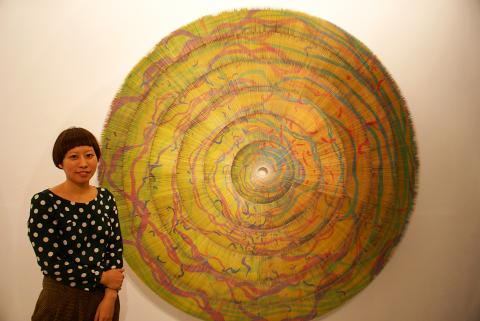
Photo: Noah Buchan, Taipei times, and courtesy of Mia Liu
Watching the sculptures rotate is a thing to behold because the colors and shapes constantly shift depending on how light is refracted off their surfaces. Are they a kind of mandala, meant as a prompt to contemplate the flux and impermanence of existence? Or perhaps their constantly changing appearance is a metaphor for the contingency of human perception.
Liu offered a more mundane explanation.
“It’s just about mixing different colors with light [based] on patterns that I draw on a daily basis,” she said.
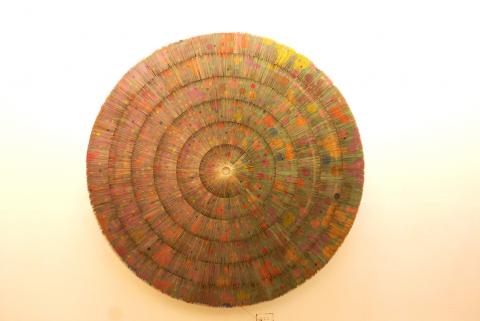
Photo: Noah Buchan, Taipei times, and courtesy of Mia Liu
Reflecting on the exhibit’s title, Liu’s meaning becomes clear. We aren’t supposed to use our reason to look for any deeper meaning, but feel and experience the sculpture’s aesthetic beauty.
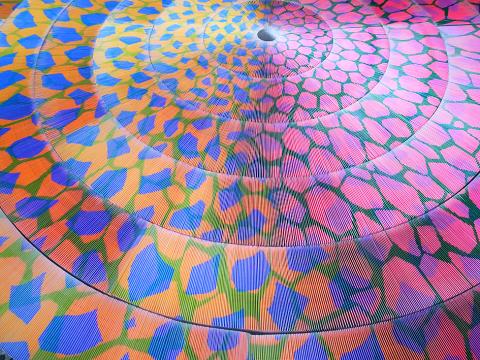
Photo: Noah Buchan, Taipei times, and courtesy of Mia Liu
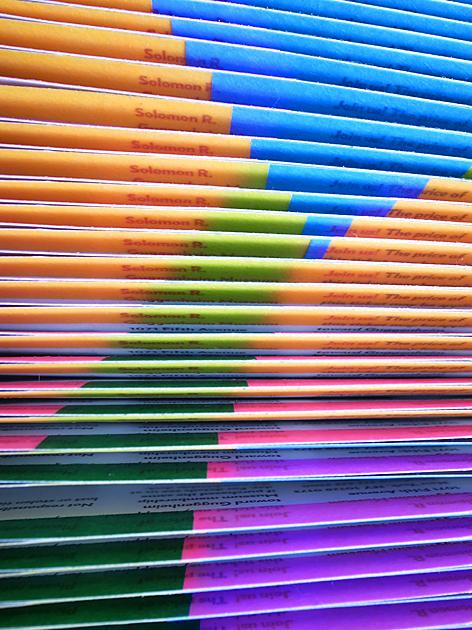
Photo: Noah Buchan, Taipei times, and courtesy of Mia Liu
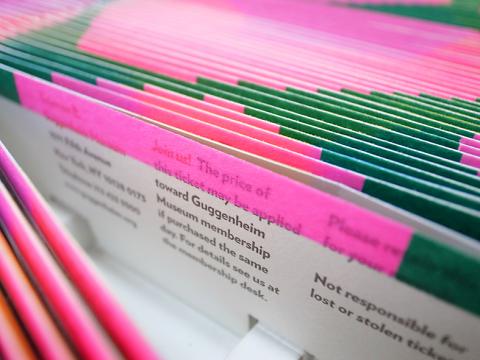
Photo: Noah Buchan, Taipei times, and courtesy of Mia Liu

In Taiwan there are two economies: the shiny high tech export economy epitomized by Taiwan Semiconductor Manufacturing Co (TSMC, 台積電) and its outsized effect on global supply chains, and the domestic economy, driven by construction and powered by flows of gravel, sand and government contracts. The latter supports the former: we can have an economy without TSMC, but we can’t have one without construction. The labor shortage has heavily impacted public construction in Taiwan. For example, the first phase of the MRT Wanda Line in Taipei, originally slated for next year, has been pushed back to 2027. The government

July 22 to July 28 The Love River’s (愛河) four-decade run as the host of Kaohsiung’s annual dragon boat races came to an abrupt end in 1971 — the once pristine waterway had become too polluted. The 1970 event was infamous for the putrid stench permeating the air, exacerbated by contestants splashing water and sludge onto the shore and even the onlookers. The relocation of the festivities officially marked the “death” of the river, whose condition had rapidly deteriorated during the previous decade. The myriad factories upstream were only partly to blame; as Kaohsiung’s population boomed in the 1960s, all household

Allegations of corruption against three heavyweight politicians from the three major parties are big in the news now. On Wednesday, prosecutors indicted Hsinchu County Commissioner Yang Wen-ke (楊文科) of the Chinese Nationalist Party (KMT), a judgment is expected this week in the case involving Hsinchu Mayor Ann Kao (高虹安) of the Taiwan People’s Party (TPP) and former deputy premier and Taoyuan Mayor Cheng Wen-tsan (鄭文燦) of the Democratic Progressive Party (DPP) is being held incommunicado in prison. Unlike the other two cases, Cheng’s case has generated considerable speculation, rumors, suspicions and conspiracy theories from both the pan-blue and pan-green camps.

Stepping inside Waley Art (水谷藝術) in Taipei’s historic Wanhua District (萬華區) one leaves the motorcycle growl and air-conditioner purr of the street and enters a very different sonic realm. Speakers hiss, machines whir and objects chime from all five floors of the shophouse-turned- contemporary art gallery (including the basement). “It’s a bit of a metaphor, the stacking of gallery floors is like the layering of sounds,” observes Australian conceptual artist Samuel Beilby, whose audio installation HZ & Machinic Paragenesis occupies the ground floor of the gallery space. He’s not wrong. Put ‘em in a Box (我們把它都裝在一個盒子裡), which runs until Aug. 18, invites